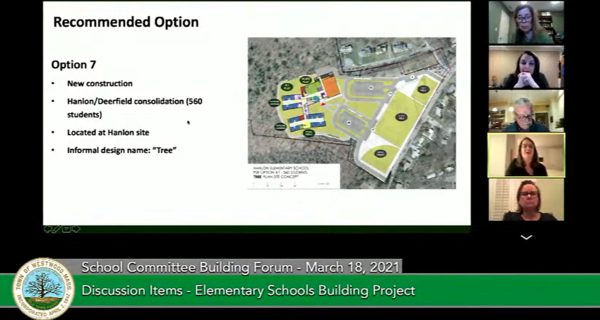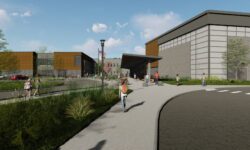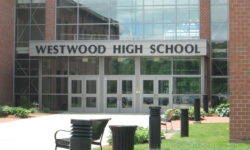The design choice for the new school was named the “tree” option.
By James Kinneen
Hometown Weekly Reporter
On Thursday night, the Westwood School Committee held a meeting to outline why they felt a consolidation of Hanlon and Deerfield Elementary Schools would be the town’s best option for a variety of reasons, from costs to the way students would need to be redistricted.
Maya Plotkin began the night by noting how they view the project as one that’s “community-wide,” as the new school on the existing Hanlon sites would provide the town with a new regulation-sized baseball field, soccer field and large gymnasium, while creating “new and improved traffic patterns” by keeping cars and buses of Gay Street.
Next, Emily Parks explained that a study found Hanlon was the school most in need of repair, noting that having been built in the 50s not only made the building old, but lacking in things modern schools emphasize that 50s educators weren’t very concerned with - like special education classrooms, and rooms that allowed privacy for school psychologists and speech therapists.
To emphasize her points, Westwood Media Center played a slideshow set to some very melancholy piano music showing just how rough a shape Hanlon and Deerfield schools are in. Lowlights included Hanlon’s ceiling collapse, mold in Deerfield’s modular classrooms and a psychology room that was created out of a closet.
After, the Committee briefly discussed the project’s history, including their partnering with the Massachusetts School Building Authority (MSBA) in 2017 for a feasibility project. Noting that they thoroughly looked into the issue of replacing or repairing, Parks showed a picture of an old Volkswagen station wagon. She explained that as good as that car, which she’d grown up with, was, at some point the costs of repair were greater than the car was worth, and that with no seatbelts, car seat hooks or airbags, a car that was good in the 70s would not be good for kids today. This, she explained, is where the town is with the Hanlon School.
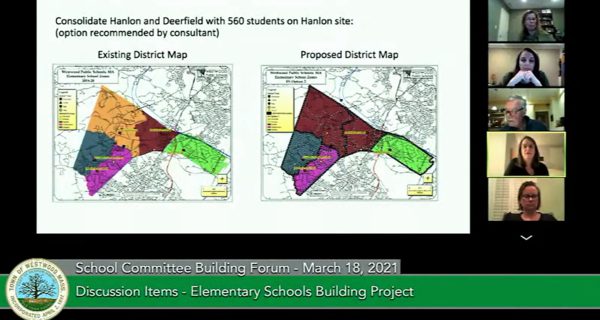
Those who studied the town’s redistricting determined that the Hanlon and Deerfield consolidation would also be the easiest for a couple of reasons. First, you essentially just erase the border between Hanlon and Deerfield’s districts to determine the 560 students in the new consolidated school. Second, in doing so, you create what Parks deemed a “right-sized school” by combining two very small schools to create one that’s not too big.

While Westwood still hasn’t received an official amount of money they would be reimbursed for by the MSBA, from the over $87m project, the school board estimates Westwood’s town share (the share for which the town will be responsible) will be a little over $69m. As for what that means for your annual taxes, Plotkin said: “Take your home’s assessed value, divide it by 100,000 and multiply that by 64.8.” In that equation, 64.8 represents the years past 2023, when the debt for the high school ends.
Maya explained that there is no “do nothing” option, as due to their age and issues, it will take a lot of money just to get Hanlon and Deerfield up to code. While the vote for the overall project may come in October, in May, the group is looking for about a million and a half dollars in “bridge funding” for things like design development. This money would not be in addition to the overall project cost, but would just be allocated from the overall cost at an earlier time.
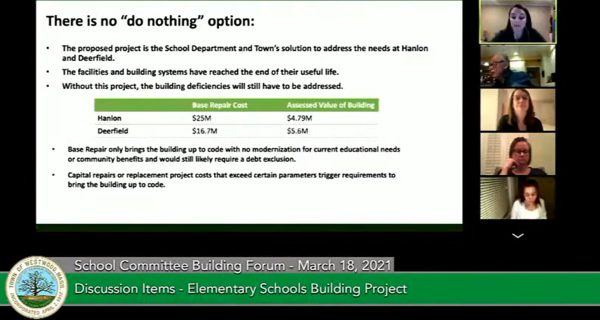
Most questions from the public revolved around what the project would mean to Sheehan School. Unfortunately, because part of the MSBA’s criteria involves what towns have received money in the past, according to Plotkin, going ahead with this project means the Sheehan School is extremely unlikely to get any funds from them and would likely need to come exclusively from Westwood taxpayers (she also noted the money they were receiving from the MSBA is less than the high school project, because things are run much differently there now than they were at that time). With citizens noting having heard rumblings about a new fire station and town hall, fears about both where Sheehan would fall in the town’s priorities and how much taxes would be raised if all these projects took place, was a notable issue.
Another issue was the project’s overall price. One citizen noted that the Sunita Williams School in Needham was much cheaper (although that was initially a school the group compared this project to), and was told the projects were different in many ways, including lot size. Another person asked if there was anything that could be cut to make the project cheaper. Plotkin abandoned the car metaphor and instead noted: “We’re not trying to build the Taj Mahal,” then listed a few of the fancy assets they opted not to have in the building, while also explaining they could look closer at cost cutting during the design phase.




